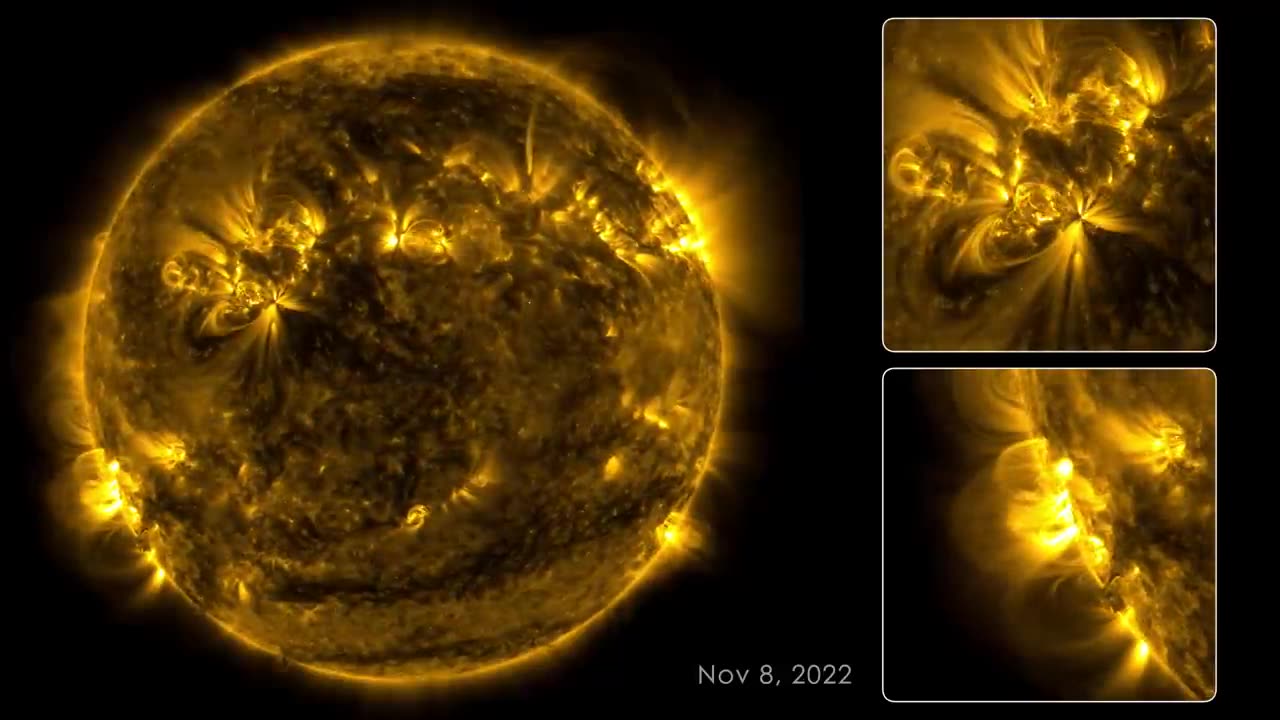Premium Only Content

A Span of 133 Days Within the Sun
This time-lapse sequence documents the solar activity spanning from August 12 to December 22, 2022, meticulously captured by NASA's Solar Dynamics Observatory (SDO). Positioned in space orbit around Earth, SDO has consistently observed the Sun in remarkable 4K x 4K resolution for nearly 13 years. This invaluable data has led to a plethora of fresh insights into the intricate workings of our nearest star and its influential role within the solar system.
Equipped with a trio of instruments, SDO captures a snapshot of the Sun every 0.75 seconds. The Atmospheric Imaging Assembly (AIA) instrument, acting alone, captures images at ten distinct wavelengths of light every 12 seconds. The focus of this 133-day time-lapse revolves around images taken at a wavelength of 17.1 nanometers, revealing the corona—the Sun's outermost atmospheric layer—in the realm of extreme-ultraviolet light.
Through the alignment of images separated by a mere 108 seconds, this visual journey encapsulates 133 days, or approximately four months, of solar observations within a concise 59-minute sequence. The footage showcases vibrant active regions traversing the Sun's surface as it gracefully rotates, completing one rotation about every 27 days.
The enigmatic loops extending above these luminous regions are magnetic fields entrapping heated, radiant plasma. These radiant zones are also the wellspring of solar flares, manifesting as luminous flashes due to magnetic fields coalescing through magnetic reconnection—a dynamic process.
Although SDO has vigilantly focused on the Sun, there are instances it missed. Instances of darkness in the imagery arise when Earth or the Moon briefly block SDO's view of the Sun during transit. Other interruptions stem from instrument maintenance or data discrepancies. SDO diligently transmits an astonishing 1.4 terabytes of data to the ground daily.
Images where the Sun appears off-center denote moments of SDO's instrument calibration. Looking ahead, SDO and fellow NASA missions are poised to maintain their watch over the Sun, continuing to unveil insights about our celestial context while offering crucial information to ensure the safety of astronauts and space assets.
The music accompanying this visual journey is an uninterrupted mix from Lars Leonhard's album "Geometric Shapes," graciously provided by the artist.
Credit: NASA's Goddard Space Flight Center
Scott Wiessinger (PAO): Lead Producer
Tom Bridgman (SVS): Lead Visualizer
Scott Wiessinger (PAO)
#SolarRumbleSaga 🌞⚡
#SunsationalThunder ⚡🌞
#EpicSolarStorm 🌞🌩️
#CosmicRumbleFrenzy 🌌⚡
#RadiantSunEruption ☀️🔥
#SpectacularSolarSymphony 🌞🎶
#CelestialThunderDance ⚡🌟
#SolarShockwaveSensation 🌞💥
#AstroSonicBoom 🚀🔊
#ElectrifyingSunShow ⚡🌞
#SolarEruptionSerenade ☀️🎶
#RumblingCelestialStage 🌌⚡
#SunburstHarmony 🌞🎵
#CosmicThunderstorm ⚡🌠
#RadiantRumbleShow 🌞🔊
#SunSonicSymphony 🌞🎶
#CelestialRumbleMagic ⚡✨
#EnergeticSunbeats 🌞🔊
#SolarRumbleChoreography ☀️💃
#ThunderousSolarEruption ⚡🌞
#SolarRumbleSaga 🌞⚡
#SunsationalThunder ⚡🌞
#EpicSolarStorm 🌞🌩️
#CosmicRumbleFrenzy 🌌⚡
#RadiantSunEruption ☀️🔥
#SpectacularSolarSymphony 🌞🎶
#CelestialThunderDance ⚡🌟
#SolarShockwaveSensation 🌞💥
#AstroSonicBoom 🚀🔊
#ElectrifyingSunShow ⚡🌞
-
 23:01
23:01
Mrgunsngear
1 day ago $4.23 earnedWolfpack Armory AW15 MK5 AR-15 Review 🇺🇸
64.9K12 -
 25:59
25:59
TampaAerialMedia
1 day ago $2.01 earnedUpdate ANNA MARIA ISLAND 2025
38.3K3 -
 59:31
59:31
Squaring The Circle, A Randall Carlson Podcast
12 hours ago#039: How Politics & War, Art & Science Shape Our World; A Cultural Commentary From Randall Carlson
29.9K2 -
 13:21
13:21
Misha Petrov
12 hours agoThe CRINGIEST Thing I Have Ever Seen…
23.8K48 -
 11:45
11:45
BIG NEM
8 hours agoWe Blind Taste Tested the Best Jollof in Toronto 🇳🇬🇬🇭
16K -
 15:40
15:40
Fit'n Fire
12 hours ago $0.32 earnedArsenal SLR106f & LiteRaider AK Handguard from 1791 Industries
14K1 -
 8:34
8:34
Mike Rowe
6 days agoWhat You Didn't Hear At Pete's Confirmation Hearing | The Way I Heard It with Mike Rowe
51.6K23 -
 7:13:44
7:13:44
TonYGaMinG
13 hours ago🟢LATEST! KINGDOM COME DELIVERANCE 2 / NEW EMOTES / BLERPS #RumbleGaming
72.5K4 -
 40:17
40:17
SLS - Street League Skateboarding
4 days agoEVERY 9 CLUB IN FLORIDA! Looking back at SLS Jacksonville 2021 & 2022 - Yuto, Jagger, Sora & more...
113K1 -
 2:00:47
2:00:47
PaddysParlorGames
22 hours agoSunday Parlor Chill: GOBSTEIN
71.1K5